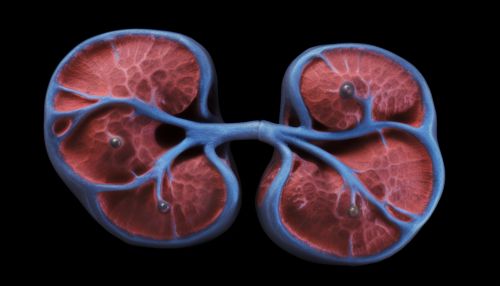Water homeostasis
Introduction
Water homeostasis, also known as fluid balance, is a crucial aspect of human physiology. It involves the regulation of the amount and concentration of water in the body, ensuring that the body's internal environment remains stable and constant. This process is intricately linked with the control of electrolyte levels in the body, particularly sodium and potassium ions.
Physiology of Water Homeostasis
The human body is approximately 60% water, and this proportion must be tightly regulated to ensure proper physiological function. Water homeostasis is maintained through a complex interplay of various mechanisms, including thirst, antidiuretic hormone (ADH) secretion, and kidney function.
Thirst Mechanism
Thirst is a fundamental component of water homeostasis. It is triggered by an increase in the concentration of solutes in the blood (osmolarity), a decrease in blood volume or pressure, or by certain hormones. The hypothalamus in the brain detects these changes and initiates the sensation of thirst. This encourages water intake, restoring the balance of water in the body.
Antidiuretic Hormone (ADH)
ADH, also known as vasopressin, plays a key role in maintaining water balance. It is produced by the hypothalamus and released by the posterior pituitary gland in response to increased blood osmolarity or decreased blood volume. ADH acts on the kidneys, promoting water reabsorption and thus decreasing urine output. This helps to restore water balance in the body.
Kidney Function
The kidneys are vital organs in the regulation of water homeostasis. They filter the blood, removing waste products and excess ions and water, which are excreted as urine. The amount of water reabsorbed in the kidneys is influenced by ADH, ensuring that the body's water balance is maintained.


Disorders of Water Homeostasis
Disruptions in water homeostasis can lead to various disorders, including dehydration, overhydration, and electrolyte imbalances.
Dehydration
Dehydration occurs when the body loses more water than it takes in. This can be caused by inadequate water intake, excessive water loss (e.g., through sweating, vomiting, or diarrhea), or a combination of both. Symptoms of dehydration include thirst, dry mouth, fatigue, and decreased urine output.
Overhydration
Overhydration, or water intoxication, is a condition that occurs when the body takes in more water than it can excrete. This can dilute the electrolytes in the body, particularly sodium, leading to a condition known as hyponatremia. Symptoms of overhydration include nausea, headache, confusion, and in severe cases, seizures or coma.
Electrolyte Imbalances
Electrolyte imbalances can also result from disruptions in water homeostasis. For example, hyponatremia can occur when there is too much water relative to sodium in the body, while hypernatremia can occur when there is too little water relative to sodium. Both conditions can have serious health consequences if not promptly addressed.
Conclusion
Water homeostasis is a complex process that involves various physiological mechanisms, including thirst, ADH secretion, and kidney function. Disruptions in this process can lead to a range of disorders, including dehydration, overhydration, and electrolyte imbalances. Understanding the intricacies of water homeostasis is crucial for maintaining health and preventing disease.
